
- Homepage
- Features
- 1st Edition (28)
- Antique, Inscribed \ (2)
- Embossed (8)
- Framed (4)
- Full Of Orig Photos (2)
- Hand Tinted (9)
- Illustrated (7)
- Limited Edition (8)
- One Of A Kind (ooak) (89)
- Photo Book (7)
- Press Photograph (4)
- Rare (2)
- Signed (4)
- Standard (3)
- Stereoscopic (9)
- Stereoview (6)
- Tintype (7)
- Union Case (39)
- Unknown (2)
- ... (6670)
- Listed By
- Material
- Subject
- Children & Infants (21)
- Civil War (31)
- Civil War Soldier (12)
- Ethnic (17)
- Family (23)
- Fashion & Costumes (10)
- Figures & Portraits (149)
- Genealogy (10)
- Historic & Vintage (90)
- History (23)
- Men (58)
- Men, Civil War (53)
- Men, Military (39)
- Military (91)
- Military & Political (565)
- Military & War (14)
- Portrait (15)
- Portraits (14)
- Soldier (12)
- Women (18)
- ... (5645)
- Theme
- Americana (40)
- Americana, Fashion (18)
- Americana, Militaria (17)
- Antique (8)
- Art (7)
- Civil War (14)
- Conflicts & Wars (6)
- Fashion (19)
- History (43)
- History, Militaria (10)
- Love (6)
- Militaria (999)
- Patriotic (7)
- People (21)
- Politics (11)
- Portrait (65)
- Portrait, Man (22)
- Stamps (22)
- Travel (6)
- Victorian (7)
- ... (5562)
- Type
- Belt Buckle (3)
- Carte De Visite (2)
- Cdv (3)
- Cdv Photograph (14)
- Daguerreotype (3)
- Full Cdv Photo Album (2)
- Illustrated Book (3)
- Negative Film Photo (4)
- Pendant (3)
- Photo Album (3)
- Photo Frame (2)
- Photograph (1305)
- Photograph Album (49)
- Picture Book (8)
- Picture Frames (8)
- Print (3)
- Real Photo (rppc) (9)
- Tintype (9)
- Tintype Photo (4)
- ... (5473)
Carte de visite CDV soldier Baltimore musician during the Civil War RARE
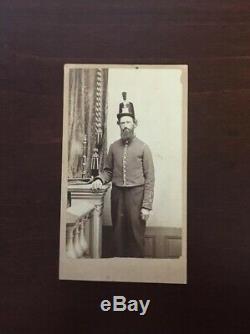
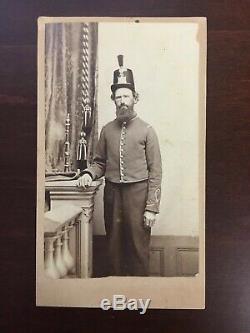
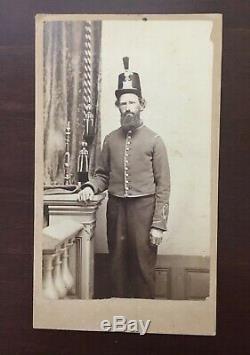
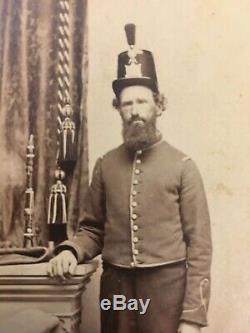

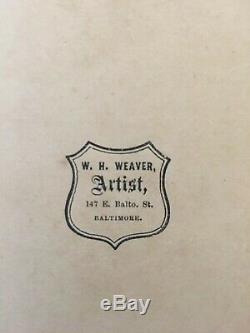



RARE CDV of a Musician from Baltimore during Civil War Clarinet player! Outstanding carte de visite of a soldier from Baltimore of a musician during the American Civil War standing next to his clarinet on a stand. He wears the frock coat of an enlisted soldier and the shako of a Baltimore city guard. Would make a great gift for a Military historian. Pice measures 4 ¼ x 2 ½ inches.
Truly fantastic pieces of history. A must for the SERIOUS Collector of American history. Authenticated by the Curator of the West Point Museum. Brief History of American Civil War.
Focused on slavery and states rights, these issues came to a head following the election of Abraham Lincoln in 1860. Over the next several months eleven southern states seceded and formed the Confederate States of America. During the first two years of the war, Southern troops won numerous victories but saw their fortunes turn after losses at Gettysburg and Vicksburg in 1863. From then on, Northern forces worked to conqueror the South, forcing them to surrender in April 1865.
Civil War: Causes & Secession The roots of the Civil War can be traced to increasing differences between North and South and their growing divergence as the 19th century progressed. Chief among the issues were the expansion of slavery into the territories, the South's declining political power, states rights, and the retention of slavery. Though these issues had existed for decades, they exploded in 1860 following the election of Abraham Lincoln who was against the spread of slavery.As a result of his election, South Carolina, Alabama, Georgia, Louisiana, and Texas seceded from the Union. First Shots: Fort Sumter & First Bull Run on April 12, 1861, the war began when Brig.
Beauregard opened fire on Fort Sumter in Charleston harbor forcing its surrender. In response to the attack, President Lincoln called for 75,000 volunteers to suppress the rebellion.
While Northern states responded quickly, Virginia, North Carolina, Tennessee, and Arkansas refused, opting to join the Confederacy instead. In July, Union forces commanded by Brig.Irvin McDowell began marching south to take the rebel capital of Richmond. On the 21st, they met a Confederate army near Manassas and were defeated.
George McClellan was given command of the new Union Army of the Potomac. In early 1862, he shifted south to attack Richmond via the Peninsula. Moving slowly, he was forced to retreat after the Seven Days Battles.This campaign saw the rise of Confederate Gen. After beating a Union army at Manassas, Lee began to move north into Maryland. McClellan was sent to intercept and won a victory at Antietam on the 17th. Unhappy with McClellan's slow pursuit of Lee, Lincoln gave command to Maj.
In December, Burnside was beaten at Fredericksburg and replaced by Maj. The following May, Lee engaged and defeated Hooker at Chancellorsville, VA. Grant captured Forts Henry and Donelson. Two months later he defeated a Confederate army at Shiloh, TN.
On April 29, Union naval forces captured New Orleans. To the east, Confederate Gen. Braxton Bragg attempted to invade Kentucky but was repelled at Perryville on October 8. That December he was beaten again at Stones River, TN.
Grant now focused his attention on capturing Vicksburg and opening the Mississippi River. After a false start, his troops swept through Mississippi and laid siege to the town on May 18, 1863. Turning Points: Gettysburg & Vickburg In June 1863, Lee began to move north towards Pennsylvania with Union troops in pursuit. Following the defeat at Chancellorsville, Lincoln turned to Maj. George Meade to take over the Army of the Potomac.On July 1, elements of the two armies clashed at Gettysburg, PA. After three days of heavy fighting, Lee was defeated and forced to retreat.
Combined these victories were the beginning of the end for the Confederacy. William Rosecrans advanced into Georgia and were defeated at Chickamauga. Fleeing north, they were besieged at Chattanooga. Grant was ordered to save the situation and did so winning victories at Lookout Mountain and Missionary Ridge. The following spring Grant departed and gave command to Maj.Moving south, Sherman took Atlanta and then marched to Savannah. After reaching the sea, he moved north pushing Confederate forces until their commander, Gen. Joseph Johnston surrendered at Durham, NC on April 18, 1865. Grant's campaign began in May, with the armies clashing at the Wilderness. Despite heavy casualties, Grant pressed south, fighting at Spotsylvania C.
Unable to get through Lee's army to Richmond, Grant attempted to cut the city off by taking Petersburg. Lee arrived first and a siege began. On April 2/3, 1865, Lee was forced to evacuate the city and retreat west, allowing Grant to take Richmond. On April 9, Lee surrendered to Grant at Appomattox Court House.
Aftermath On April 14, five days after Lee's surrender, President Lincoln was assassinated while attending a play at Ford's Theater in Washington. The assassin, John Wilkes Booth, was killed by Union troops on April 26 while fleeing south. Following the war, three amendments were added to the Constitution which abolished slavery (13th), extended legal protection regardless of race (14th), and abolished all racial restrictions on voting (15th).During the war, Union forces suffered approximately 360,000 killed (140,000 in battle) and 282,000 wounded. Confederate armies lost approximately 258,000 killed (94,000 in battle) and an unknown number of wounded. The total killed in the war exceeds the total deaths from all other US wars combined. Civil War Battles The battles of the Civil War were fought across the United States from the East Coast to as far west as New Mexico.
Beginning in 1861, these battles made a permanent mark upon the landscape and elevated to prominence small towns that had previously been peaceful villages. As a result, names such as Manassas, Sharpsburg, Gettysburg, and Vicksburg became eternally entwined with images of sacrifice, bloodshed, and heroism. It is estimated that over 10,000 battles of various sizes were fought during the Civil War as Union forces marched towards victory.
During the Civil War, over 200,000 Americans were killed in battle as each side fought for their chosen cause. The Civil War was the first conflict that saw the large scale mobilization of the American people. While over 2.2 million served the Union cause, between 1.2 and 1.4 million enlisted in Confederate service. These men were led by officers from a variety of backgrounds ranging from professionally-trained West Pointers to businessmen and political appointees. While many professional officers did leave the US Army to serve the South, the majority remained loyal to the Union. As the war began, the Confederacy benefited from several gifted leaders, while the North endured a string of poor commanders. In time, these men were replaced by skilled men who would lead the Union to victory. The item "Carte de visite CDV soldier Baltimore musician during the Civil War RARE" is in sale since Thursday, October 3, 2019. This item is in the category "Collectibles\Militaria\Civil War (1861-65)\Original Period Items\Photographs". The seller is "pa-history-coll" and is located in New York, New York.This item can be shipped to United States.
- Modified Item: No
- Country/Region of Manufacture: United States

